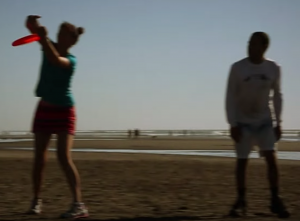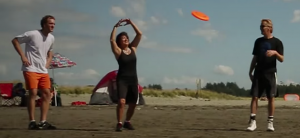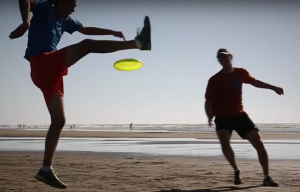Ryan Young demonstrates how to cuff the disc to flatten it while on a brushing run. Often times, especially when in high speed wind, the disc will become too steep during a brushing run. This can cause the pace of the run to suddenly change, which creates break in the flow of the jam. It also can cause a loss of control as you run into or past the disc. In more severe wind, the disc can blow behind you and roll away. By using the skill Ryan is demonstrating you can maintain control and even avoid any break in the flow of the jam.
OK, so let’s break it down. There are three steps; brush to add spin, cuff to flatten, and brush to continue the run.
Let’s say you’re on a run and the disc becomes to steep. On challenge may be that it is spinning quite slowly. Of course, cuffs use a lot of spin. So, Ryan suggests first doing a quick brush to add spin. This is step one. I often do this before a cuff as well and not just for this circumstance. With practice, the brush-to-cuff becomes a single move instead of two. The key to success here is to change the height of the disc as little as possible. Think “stun it”.
Now it’s time to cuff it flat. With clock spin, touch it lightly at 3 o’clock with the back of your hand. With counter, touch it at 9 o’clock. If your hand is wet, all the better…the wetness reduces friction. However, this is not required. As you touch, slowly lift and left the disc glide. As you lift your hand the disc will flatten out. Ryan suggests slowly moving your hand towards 6 o’clock. Just remember, soft touch and let the disc glide.
Once the disc is at the desired angle, it’s time to brush it again and continue the run. Exactly which brush you use will depend the situation after the cuff. But, as Ryan suggests, this brush must happen quickly. The key here is to use this brush to maintain/regain control. It’s not about adding spin or perfect placement. Just get it back into the air where you can deal with it. And, be ready to brush with either hand, especially in a strong wind, because the disc could now be quite high in the air. Or, in lower wind it might be falling really fast so even a kick brush or kick tip may be in order. Ryan suggests trying to connect the cuff to the next brush. This is a great suggestion as the cuff-to-brush will eventually become a single move. My latest adaptation is to let the cuff turn into a guide so I can, with a single contact, flatten the disc and then push it forward gently to give myself enough time for next trick…no third brush required.
This brush–cuff-brush skill, though not sexy, will greatly enhance your ability to maintain control over disc that’s become too steep and is starting to get away. We’d love to hear your strategies for maintaining disc control. Let us know in the comments.



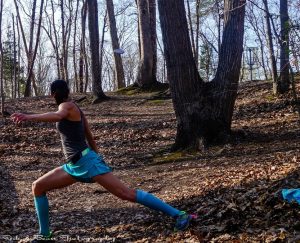

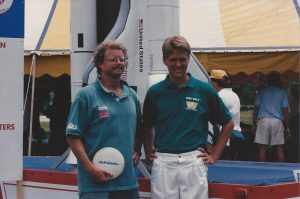

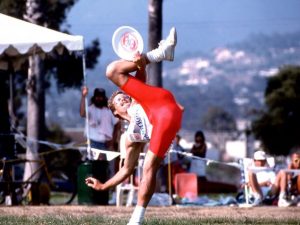

 Bad attitude is named after the dance position called attitude, except it’s a bad version of it. I am the perfect example of how bad the attitude can be. My flexibility is limited so the
Bad attitude is named after the dance position called attitude, except it’s a bad version of it. I am the perfect example of how bad the attitude can be. My flexibility is limited so the 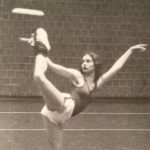 Of course when I do it, it’s not so pretty. But, when done properly, it can be quite beautiful. Here’s Sue Straight showing us a proper bad attitude. Don’t worry if you don’t look like Sue. The bad attitude is a fun, explosive, and surprising catch that will grab attention no matter your form.
Of course when I do it, it’s not so pretty. But, when done properly, it can be quite beautiful. Here’s Sue Straight showing us a proper bad attitude. Don’t worry if you don’t look like Sue. The bad attitude is a fun, explosive, and surprising catch that will grab attention no matter your form.